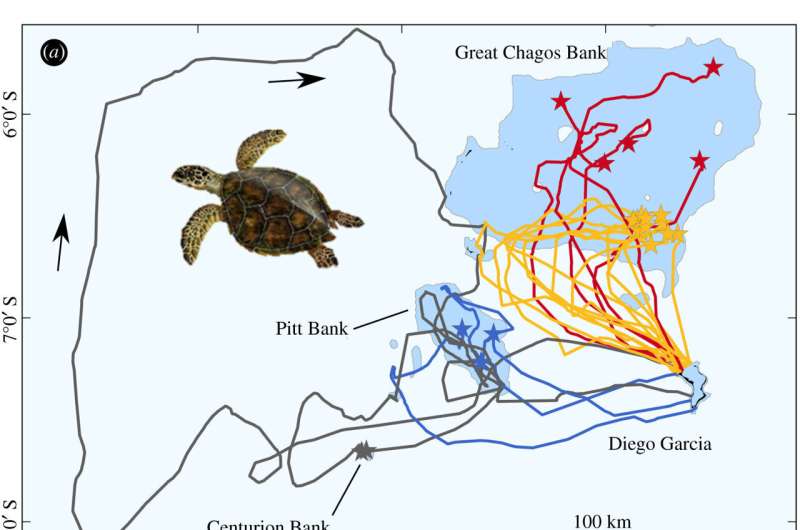May 11, 2022 report
Hawksbill turtles have relatively crude navigational skills

A small international team of researchers has found that hawksbill turtles take a circuitous route during migration, suggesting they have relatively crude navigational skills. In their paper published in Journal of the Royal Society Interface, the group describes tagging multiple turtle specimens and tracking their movements to better understand their navigational skills.
Some creatures, such as sharks and pigeons, are known to have excellent navigational skills—they can travel thousands of miles to a specific destination. Others, however, are less skillful. In this new effort, the researchers found that while hawksbill turtles are able to find their desired destination, they travel much farther distances than needed.
To learn more about navigation in hawksbill turtles living in the area around the Chagos Archipelago in the western Indian Ocean, the group captured and electronically tagged 22 female specimens and set them free to follow their movements remotely. All of the females nested on Diego Garcia Island, and when not nesting, foraged in other parts of the Archipelago.
The researchers found that the turtles rarely, if ever, took a direct route to a desired location. When swimming from a foraging area to the island where they nested, for example, they generally took a circuitous route, meandering here and there in the general direction of the island. The researchers suggest their swimming route was not due to a lackadaisical approach to navigation. When they swam from the nesting area, they still swam indirectly despite not having eaten for several months; thus, even with good reason to swim in a direct route to their feeding ground, they could not. They still swam as if they were taking a casual stroll.
The researchers note that the routes the turtles must swim are generally more difficult than other migrating animals—they have to make frequent turns and change swimming depths—which may partially explain their behavior. But they also suggest that the reason the turtles take such indirect routes is that they lack precision navigational skills, which means they are doing the best they can with what nature gave them.
More information: Graeme C. Hays et al, Travel routes to remote ocean targets reveal the map sense resolution for a marine migrant, Journal of The Royal Society Interface (2022). DOI: 10.1098/rsif.2021.0859
Journal information: Journal of the Royal Society Interface
© 2022 Science X Network



















